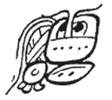| CMGG entry for syllabogram t'i
|
|
Variant: split akbal
1624st t’i?
Davletshin&Bíró-APSfT.p4.fig2a Davletshin&Bíró-APSfT.p4.fig2b Pendants 8a and 8b, Comalcalco Urn 26 Stingray Spine 4, Comalcalco Urn 26 ti.<nu:t’i:li> nu:<t’i:li>
Davletshin&Bíró-APSfT.p4.fig2c Davletshin&Bíró-APSfT.p4.fig2d K1815 K2208 nu:<t’i:li> nu:<t’i:li>
1624hc t’i?
· Davletshin&Bíró-APSfT is the paper which first proposed the reading of this glyph as t’i. o Davletshin&Bíró-APSfT.p4.c1.para2.l+2: The sign in question is not registered in Thompson’s (1962) catalog of Mayan signs, and is instead known to epigraphers by the nickname ‘Split- Akbal’ […] in order to distinguish it from the well-known logogram AK’AB “night” (long referenced in the literature as ‘Akbal’) and the ‘Flaming-Akbal’ […] [Sim: “flaming-ak’bal” is the AJ of the famous murals of the Chik Nahb marketplace in CLK.] o Davletshin&Bíró-APSfT.p4.c2. para2.l+1: the ‘Split-Akbal’ sign occurs only five times in the extant corpus: twice in texts from Comalcalco (Armijo et al. 2000, 2001; Zender 2004) and thrice on painted Codex-style ceramics. [Sim: only four of the five are shown as examples above, as the fifth is too eroded to be of real value in giving an idea of how the glyph looks.] · Davletshin&Bíró-APSfT was published in 2014, and Bonn has recognized the glyph as 1624st and assigned the pronunciation t’i (but with a question mark). o This indicates that the proposed reading has found at least some support among other epigraphers. o Bonn has even recognized a head variant: 1624hc.
|




